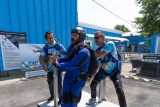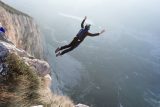Skydiving 101: Basic Terms Clarified
Skydiving
Posted by: Start Skydiving
9 months ago
Walking up to a dropzone and hearing people talk about boogies, manifesting things, creepers, and hot loading is nothing short of intimidating … like what!? There needs to be a skydiving terms dictionary because there are so many! Whether you’re a tandem student prepping for your first adventure to the DZ or a prospective solo jumper, we’ve got you covered with a breakdown of some of the most common skydiving terminology to help you feel confident venturing into the skydiving world.
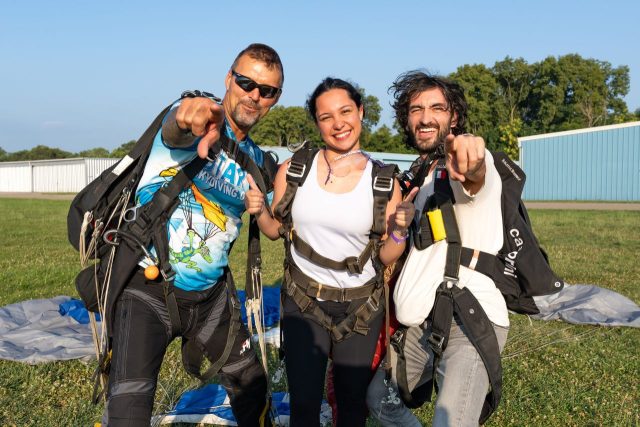
Skydiving Functions
Dropzone (DZ)
A dropzone, often referred to as a DZ, is where skydiving happens! Dropzones can be located at public or private airstrips and are equipped with everything needed for a successful skydive. Dropzones have dropzone owners (DZO), dropzone managers (DZM) and parachute packers.
Governing Bodies
The Federal Aviation Administration (FAA) and United States Parachute Association (USPA) are both governing bodies that oversee the activities of skydivers and their dropzones.
Manifest
The dropzone manifest is not some crazy, spiritual enlightening. Manifest is the place where the administration of daily dropzone tasks take place. Manifest is in charge of calling the loads when they’re ready and putting jumpers onto the loads they desire. For example, if a skydiver wants to jump on load 1, they will walk up to manifest and ask to be “manifested” on load one. A skydiver that can manifest themselves is called a fun jumper, or, a licensed skydiver.
Packer
A packer is someone who has proven they have extensive understanding of skydiving gear and how to fold the parachute back into the container. A rigger is someone who has an even more in depth understanding of skydiving gear and is certified by the FAA to repack reserves.
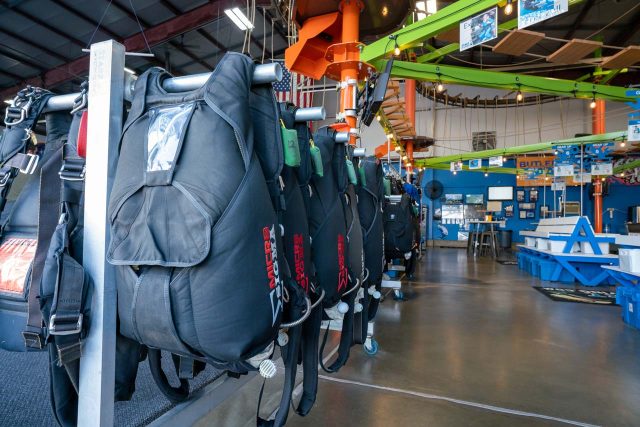
Skydiving Gear
AAD
An Automatic Activation Device, or AAD, is a teeny tiny computer with a small blade attached to it. The AAD uses a precise calculation of air pressure to understand what altitude the skydiver is at. Along with altitude, AADs take velocity into account. If the AAD deems that the skydiver is at a dangerously low altitude and is going too fast, it will fire and cut the reserve cord, allowing the reserve canopy to deploy. AADs save lives!
Canopy
A canopy is simply a parachute! If “canopy” is still too many syllables, the term “wing” can also be used to refer to a parachute. There are main canopies that are used on every jump and reserve canopies, which are back-ups. Main canopies and reserve canopies are often just called “mains” and “reserves.” We keep it short and sweet in the skydiving world!
Container
The backpack-like thing that holds both canopies and other skydiving apparatuses is called a container. A rig refers to the entire container, both canopies, and other technology (like an AAD) within the rig.
Cutaway
A cutaway is when the skydiver has an issue with their main and decides to get rid of it and deploy their reserve. A cutaway is the result of a malfunction, which is when the main canopy has a problem that makes it unconducive for a successful flight. A cutaway handle is used to get rid of the main canopy if it’s no good, and a reserve handle is pulled to deploy the reserve after the cutaway.
RSL
A Reserve Static Line (sometimes called a Reserve Static Lanyard), or RSL, is a lanyard that connects the cutaway system of the main canopy to the deployment system of the reserve canopy. It is designed to act as a tripwire – once the main is cutaway, the reserve deployment will be automatically initiated.
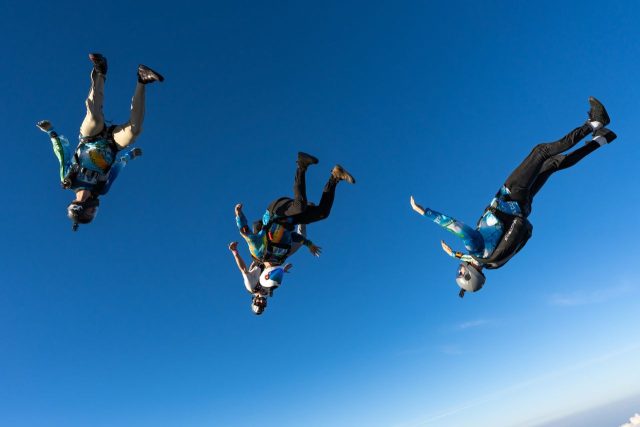
Skydiving Community
Boogies
A skydiving boogie is a party centered around skydiving! Many boogies attract jumpers from all over, some even cross oceans to attend boogies! They’re often centered around a theme, have specialty aircraft, and may support a cause, such as donating the boogie registration fee to support cancer research.
Blue Skies
Skydivers use the term “blue skies” to mean a couple things. They may be referring to the color of the sky and telling someone that there’s blue skies – meaning the skies are ready for jumping! OR, “blue skies” can be used as a way to wish someone well; it’s sort of a way to say, “I hope your life (skies) is free of worry (clouds).”
The Jumps
Beer Line
A beer line is an imaginary line (but, it’s there, we promise!!) that cannot be crossed when landing. If crossed, the jumper will owe beer to the communal fridge for after-jumping festivities.
Butter
The term “butter” or “buttery” can be used when describing the softness of a canopy opening. If the canopy opens super softly, the skydiver would refer to the opening as pure butter. A buttery opening entails a long snivel. A snivel is the time the canopy takes to fully inflate.
Cork Out
Corking out (sometimes called “slipping on banana peels”) is when the skydiver loses control of their maneuver in freefall, causing them to flip around until they regain stability.
Dirt Diving
Skydivers dive through the SKY, not the ground … right!? Right. Dirt dives simply mean practicing the skydive on the ground (dirt) prior to actually doing the jump. Dirt dives are important to make sure everyone on the jump understands their place in the dive flow (the plan of what to do during freefall). Creepers – basically glorified long boards that swivel like office chairs – are often used in dirt dives and allow skydivers to lay on their bellies and roll around to simulate the dive.
Dock
Docking is when skydivers take hold of one another in freefall to create a formation. Some skydiving suits, called jumpsuits, have grippers, which are pieces of stuffed fabric that make it easier to latch on during freefall. Canopies can also dock in multiple ways to build canopy formations!
Hop-n-Pop
A “hop” for short, is a skydive where the jumper deploys their canopy about 3-5 seconds after exit. Hops are typically from a lower altitude, but some people will hop from a high altitude–making it a high pull. If someone wants to focus on their canopy skills with minimal jumpers in the sky, they may choose to jump before everyone else and do a hop!
“Let’s Do Sunset”
“Doing sunset” means jumping on the final load of the day! The sunset load is famous for the best vibes, calmest winds, and prettiest views – everyone wants to manifest for sunset!
Meeting
“Meeting the plane,” being a “meet load,” “hot load,” or “turning,” is when the next group of skydivers to go up will get on the plane as it lands. There will be no stop time in between loads – the plane will not shut down!
No Plan Jam
A no plan jam is a skydive with no specific plan (other than safely getting back to the ground)! No plan jams have no specified dive flow other than to have fun.
Uppers
The uppers are the winds at high altitudes. Fun fact: skydivers rarely fall straight down. While in freefall, the uppers are pushing them side to side, which makes understanding the uppers critical in knowing where to spot the exit in order to ensure you’ll be able to make it back to the landing area. On the other hand, the lowers refer to the wind speed once someone is under canopy and how it will affect their landing pattern –the direction they fly their canopy while landing.
Wind Hold
A wind hold is a type of weather hold that means jumping has ceased for the moment due to unfavorable winds.
The list of skydiving vocabulary is virtually endless. Come shred the gnar for yourself – we can’t wait to rip it up with you at Start Skydiving!
